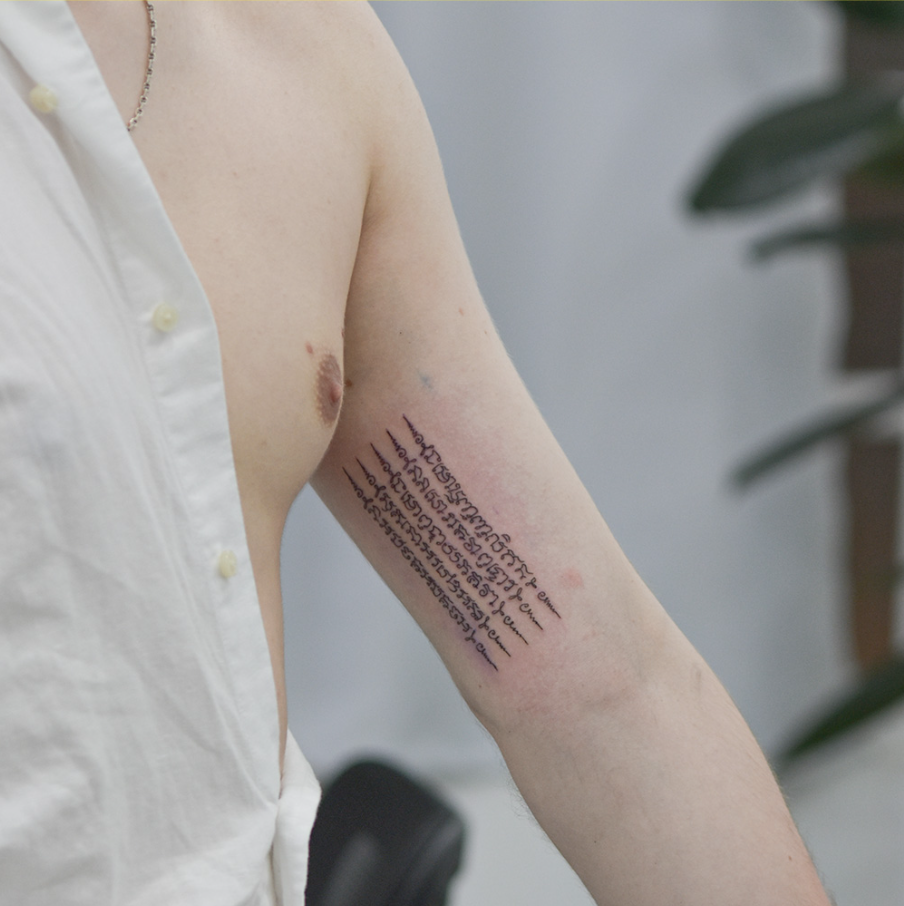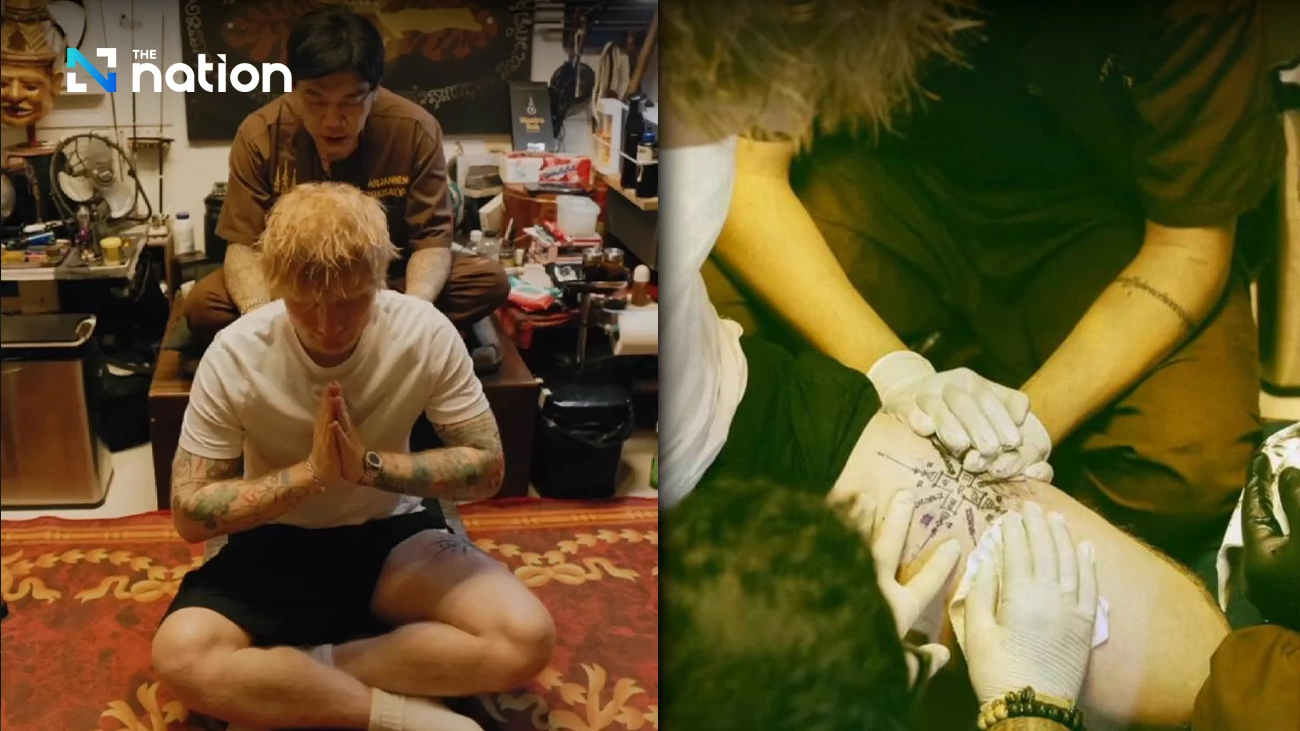Sak Yant (สักยันต์) or Yantra is an intricate and traditional form of Thai tattoos. In its purest form, it has spiritual meaning and significance. The word “sak” means “tattoo,” and “yant” comes from the Sanskrit word “yantra,” referring to sacred geometric designs or symbols.
The Sak Yant tattoo is a sacred Thai tattoo that originated in ancient Cambodia and spread to Thailand. The tattoos have elements of Buddhism, Animism, and Brahmanism. The practice has evolved over centuries to become a distinctive Thai tradition.

Popular Traditional Sak Yant Tattoo Designs
- The Hah Taew (ห้าแถว): These are five lines of script designed by a Buddhist monk, applied vertically and believed to offer protection and blessings.
- The Gao Yord (เก้ายอด): These are nine mountains or peaks that represent the nine planets and specific blessings.
- The Yant Phra Pidta: This is a design featuring a seated Buddha with hands covering the eyes. It’s believed to offer protection from temptation and evil spirits.
- The Yant Suea: This is a tiger design that can take many forms and offers protection, strength, power and courage.
As the designs carry specific meanings and purposes for each person, tattoos are often tailored to the individual’s needs or specifications.



What Is The Process Of A Traditional Sak Yant Tattoo?
Sak Yant tattoos are traditionally applied by using a metal rod or bamboo stick by a skilled monk or a tattoo master known as an “Ajarn.” Nowadays, Sak Yant tattoos may also be done using a tattoo machine. However, the meanings and spiritual aspects of the tattoos remain important.
Prayers and mantras are often recited during the tattooing process to empower and imbue the design with spiritual energy.

The Role of Monks and Ajarns For Thai Sak Yant Tattoo
Sak Yant tattoos are traditionally done by Buddhist monks in wats or temples, although some tattoo masters (Ajarn) who have received special training also practice the art in tattoo studios. The ritual of receiving a Sak Yant is a deeply spiritual experience, and it’s common for Buddhist chants to accompany the experience and for people to ask for specific blessings or protections based on their lifestyles and needs.
In some cases, the tattoo may require a specific ceremony or blessing to activate the spiritual powers of the design.
Popular Sak Yant Tattoo Placements On The Body
Thai Sak Yant tattoos are traditionally placed above the waist, which is considered the more respectful area of the body in Thai culture. This belief is rooted in spiritual symbolism, where the upper body is seen as closer to the divine. However, certain designs, particularly those featuring animals or representing more earthly elements, may be placed below the waist with the proper blessings and intention.
Here are some of the most popular placements for traditional Thai Sak Yant tattoos and the reasons behind them:
Collarbone
The Yant Soy Sung Warn design is often inked just below or along the collarbone. This placement is highly visible and is believed to offer protection and attract positive energy from the front-facing world. It’s commonly chosen for its spiritual strength and its prominent, symmetrical location.
Ribs, Arms and Hands
These areas are ideal for small Sak Yant tattoo designs that still carry powerful meaning. Tattoos on the upper arms and ribs are believed to strengthen the individual’s internal courage and discipline, while hand placements, though less common, are thought to empower one’s actions and intentions.
Shoulders, Back, and Base of the Neck
Arguably the most popular locations for Sak Yant tattoos, these areas are typically reserved for more elaborate and powerful Yants, such as the Yant Ha Taew. The back and shoulders are seen as places of strength and spiritual anchoring, offering protection from unseen dangers or negative influences approaching from behind. The base of the neck, in particular, is considered a central point for receiving blessings and connecting with higher guidance.
Other than aesthetic reasons, each placement also carries spiritual significance. A properly placed Sak Yant tattoo is believed to work in harmony with the body’s energy flow, offering ongoing protection, guidance, and empowerment.
Celebrities with Sak Yant Tattoos
Angelina Jolie was one of the first global celebrities to draw attention to traditional Thai Sak Yant tattoo designs. She received her first during her humanitarian work with the UNHCR in Cambodia – five sacred lines inked by the famed Ajarn Noo, each line symbolising blessings of protection and good fortune.
David Beckham, known for his extensive body art, also has a Sak Yant tattoo. He reportedly got it during a visit to Thailand, adding a spiritual layer to his collection with a design believed to offer strength and guidance.
Recording artist Ed Sheeran is another celebrity who has embraced Sak Yant. He opted for a traditional design placed below the waist on his leg, a permissible area depending on the tattoo’s symbolism. His experience was documented and shared with fans, helping further spotlight this sacred Thai art form.
Angelina Jolie With A Sak Yant Tattoo

Ed Sheeran With A Sak Yant Tattoo

Traditional Thai Sak Yant Tattoo Trends
Sak Yant tattoo trends continue to evolve while staying rooted in tradition. Designs like Gao Yord and Hah Taew remain popular for their protective and spiritual meanings, but there’s also growing interest in more personalised patterns, some even incorporating initials or modern motifs with the blessing of an Ajarn. While the traditional Thai Sak Yant tattoo remains deeply symbolic, more people now choose to receive them in licensed studios that follow proper hygiene, especially those visiting from abroad. This balance between authenticity and safety has helped keep Thailand traditional tattoos relevant among younger generations.
Sak Yant Tattoo Pain Levels
As for the pain, it really depends on your tolerance and where the tattoo is placed. The traditional method uses a long metal rod to hand-poke the ink into the skin, which feels quite different from a machine tattoo – some say it’s sharper, but more bearable over time. The spine, ribs, and collarbone are known to be more sensitive, while fleshier areas like the shoulders or upper arms are easier to handle. Most who choose a Sak Yant see the pain as part of the ritual, making the experience all the more meaningful.
Get A Sak Yant Tattoo At PUREInk Tattoo Studio In Bangkok
Many Thai people choose to get a Sak Yant tattoo to mark significant moments in their lives. At PUREInk, this sacred form of Yantra tattooing is carried out with deep respect for Thai Buddhist traditions and the cultural roots of the practice. If you’re looking for a trusted Sak Yant tattoo studio in Bangkok, PUREInk offers a high-quality, authentic experience guided by skilled artists who honour the spirit of this ancient art form.

